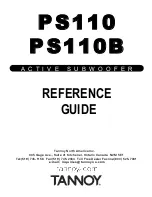
4
Moving the subwoofer
Always use two people to lift and move the subwoofer into place. Do not drag the subwoofer, as this can leave
streak marks on the flooring surface and scratch marks on the subwoofer. Screw on the rubber feet securely
before moving the subwoofer into place.
Step 3: Hookup
We will refer to receivers, integrated amplifiers, and preamps as
controllers
.
Take a look at the back of your controller. The output connectors available
determine the best method of hooking up your subwoofer.
Method A. Connecting to controllers
with a SUBWOOFER or LFE output
If you have this, you should use it. All Dolby Digital, DTS, THX, and Bass Management
equipped controllers have a low level SUBWOOFER or LFE output. It offers the easiest and
best connection. Run a cable from it to the subwoofer’s low level SUB-IN input. A standard
mono interconnect cable with RCA jacks on both ends can be purchased from electronics
and audio stores. A special subwoofer cable is not needed, and neither is a Y-connector.
When wiring, allow for an extra yard or two. The cables should lie flat with a little bit of
slack to give you some placement flexibility.
Set your controller to enable subwoofer output. To do this, go to the SPEAKER SET-UP or BASS
MANAGEMENT menu and set the SUBWOOFER to ON or YES. All the speakers should be set to
SMALL if possible. This directs the deep bass from the satellites to the subwoofer, freeing them and
their amplifiers from the rigorous demands of reproducing bass.
Method B. Connecting to controllers
with HIGH LEVEL speaker outputs.
If your system does not have a SUBWOOFER or LFE output (for example, stereo-only
integrated amps or older Dolby Pro Logic receivers) you can use the HIGH LEVEL speaker
outputs. The subwoofer taps the signal from the controller’s amplifier, letting the subwoofer
reproduce the bass of the left and right channels. This method is also called bass augmentation.
Since the subwoofer uses its own amplifier there is no noticeable drain on your main amplifier.
You will need to run two lengths of two conductor speaker cable or zip cord. This wire is not
included with your subwoofer but can be purchased at electronic or home improvement stores.
Strip 1⁄2˝ of insulation from each end of the wire to expose the bare metal. If your speaker wire
is fraying, tightly twist the metal. Unscrew the plastic hex nut on the binding post to insert the
exposed wire into the hole. Tighten the binding posts by hand.
Run the wires from your system’s amplifier to the subwoofer’s HIGH LEVEL INPUTS. For each channel, run wire from the red (+) out-
puts on the amplifier to the subwoofer’s red (+) inputs, and from the black (-) outputs on the amplifier to the subwoofer’s black (-) inputs.
Make sure the black amplifier outputs are “true ground.” Bridged outputs cannot be used.
Be sure to double check all connections for the correct polarity so that the positive (+) terminals go to positive (+) terminals and negative
(-) terminals go to negative (-) terminals. Most wire has some marker to help you keep track of the polarity, such as ribbing, color coding,
or writing on one of the two strands. Tighten the binding posts by hand. If you prefer to terminate your cables, we recommend springy
banana plugs for a reliable connection. They are available from electronic and audio stores.
For older Dolby Pro-Logic controllers, your center channel must be switched to NORMAL instead of WIDE, or else the bass from the
center channel will not be fed into the subwoofer. For Dolby Digital controllers, go to the SPEAKER SET-UP or BASS MANAGEMENT
menu on your controller and turn the subwoofer to NO or OFF and set the left and right channels to LARGE.
Method C. Connecting to controllers with PRE-OUTs.
If you do not have a SUBWOOFER or LFE output but have an extra PRE-OUT, you can use this instead of the speaker outputs. Run a
stereo RCA interconnect from your PRE-OUT to the left and right inputs on the subwoofer. For Dolby Pro-Logic controllers, your center
channel must be switched to NORMAL. For Dolby Digital controllers, the subwoofer must be switched to NO or OFF and the left and
right channels set to LARGE.
If your system (a) has a MAIN-IN connected with a metal jumper to a PRE-OUT, or (b) you have an external amplifier, you can purchase our
HSU High Pass Box for the added benefit of keeping the bass out of your speakers. Please contact HSU Research for details.






























